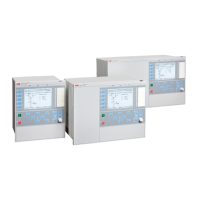protection on healthy circuit and this way endangers even more the complete system
stability.
To avoid the unwanted tripping, some manufacturers provide a feature in their distance
protection which detects that the fault current has changed in direction and temporarily
blocks distance protection. Another method employed is to temporarily block the
signals received at the healthy line as soon as the parallel faulty line protection initiates
tripping. The second mentioned method has an advantage in that not the whole
protection is blocked for the short period. The disadvantage is that a local
communication is needed between two protection devices in the neighboring bays of
the same substation.
Distance protection used on series compensated lines must have a high overreach to
cover the whole transmission line also when the capacitors are bypassed or out of
service. When the capacitors are in service, the overreach will increase tremendously
and the whole system will be very sensitive for false teleprotection signals. Current
reversal difficulties will be accentuated because the ratio of mutual impedance against
self-impedance will be much higher than for a non-compensated line.
If non-unit protection is to be used in a directional comparison mode, schemes based
on negative sequence quantities offer the advantage that they are insensitive to mutual
coupling. However, they can only be used for phase-to-ground and phase-to-phase
faults. For three-phase faults an additional protection must be provided.
3.6.2.2 Setting guidelines
General
The settings for the distance protection function are done in primary values. The
instrument transformer ratio that has been set for the analog input card is used to
automatically convert the measured secondary input signals to primary values used in
the distance protection function.
The following basics should be considered, depending on application, when doing the
setting calculations:
• Errors introduced by current and voltage instrument transformers, particularly
under transient conditions.
• Inaccuracies in the line zero-sequence impedance data, and their effect on the
calculated value of the ground-return compensation factor.
• The effect of infeed between the IED and the fault location, including the
influence of different Z0/Z1 ratios of the various sources.
1MRK504116-UUS C Section 3
IED application
235
Application manual

